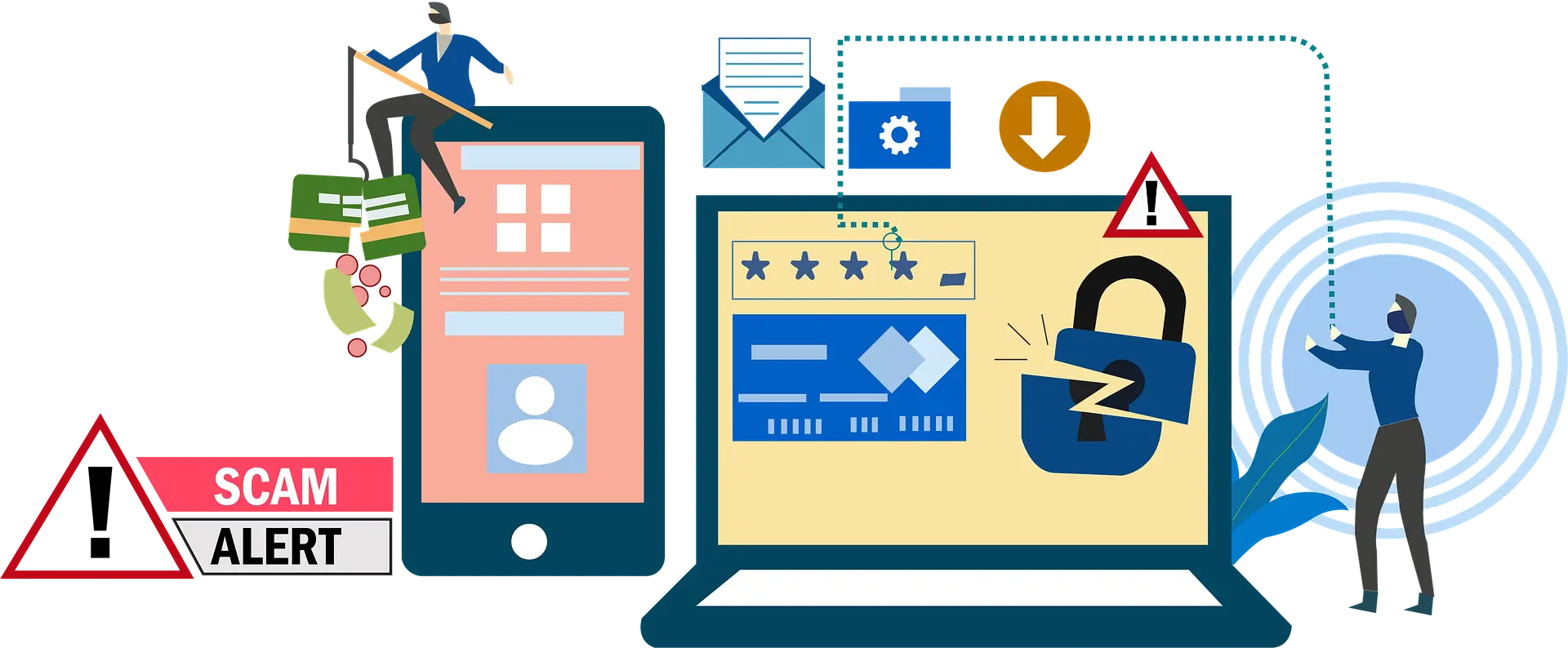Phishing scams are more sophisticated than ever. Learn how to identify red flags, protect your data, and avoid falling victim. Click to learn more!
Recognizing and Avoiding Phishing Scams: Keep Your Data Safe
The internet offers a wealth of information and connection, but it also comes with inherent risks. One of the most common threats we face online are phishing scams. Phishing attempts to trick you into revealing sensitive information, like passwords, credit card details, or social security numbers. Scammers often disguise themselves as legitimate sources like banks, credit card companies, or even social media platforms.
In today’s digital age, where much of our lives are conducted online, protecting ourselves from phishing attacks is crucial. This blog post will equip you with the knowledge and tools to recognize phishing attempts, safeguard your data, and navigate the online world with confidence.
Why Phishing Scams are So Common?
Phishing scams are popular among cybercriminals because they prey on human emotions and exploit our natural trust in familiar brands and institutions. Scammers use urgency, fear, and a sense of authority to manipulate us into acting before thinking critically. The tactics they employ are constantly evolving, making it even more important to stay informed on the latest trends.
Common Phishing Techniques:
- Email Phishing: This is the most common type of phishing attempt. Scammers send emails that appear to be from a trusted source, such as your bank, credit card company, or online service provider. The email may contain a fake login page link or an attachment that, when clicked, downloads malware onto your device.
- SMS Phishing (Smishing): Similar to email phishing, smishing involves sending fraudulent text messages that appear to be from legitimate companies, like your mobile carrier or a delivery service. These messages may contain links to phishing websites or request you to reply with personal information.
- Vishing: Phishing attempts can also take the form of phone calls (voice phishing or vishing). Scammers may pose as customer service representatives from a trusted company or government agency, claiming to detect suspicious activity on your account or offering a solution to a non-existent problem.
- Social Media Phishing: Social media platforms are another popular target for phishing attacks. Scammers may create fake profiles impersonating real people or companies, or exploit vulnerabilities in social media platforms to spread phishing links and messages.
- Spear Phishing: This is a more targeted form of phishing where scammers gather specific information about their victims beforehand. They then personalize the phishing attempt using this information, making it appear more legitimate and increasing the likelihood of success.
Signs of a Phishing Scam:
Here are some red flags that should signal caution when encountering a potential phishing attempt:
- Grammatical Errors and Typos: Legitimate companies typically have high standards for email and communication. Poor grammar, typos, and awkward phrasing can be indicators of a phishing attempt.
- Urgency and Threats: Scammers often create a sense of urgency by pressuring you to act immediately. They may threaten to suspend your account, claim fraudulent activity on your card, or offer a limited-time deal that requires immediate action.
- Suspicious Links and Attachments: Don’t click on links or open attachments in emails or messages from unknown senders. Hover over any hyperlink to see if the actual URL destination matches the displayed text. Legitimate companies will not request sensitive information through email attachments.
- Generic Greetings and Poorly Designed Landing Pages: Phishing emails often address you generically as “Customer” or “Dear User” instead of your actual name. Additionally, phishing website design may be unprofessional, with low-quality images, mismatched fonts, and broken links.
- Unbelievable Offers: Promises of “free gifts,” “too-good-to-be-true” deals, or sudden inheritance notices are classic bait-and-switch tactics often used in phishing scams.
How to Protect Yourself from Phishing Scams:
By following these steps, you can significantly reduce your risk of falling victim to a phishing attack:
- Be Wary of Unsolicited Emails and Messages: Legitimate companies rarely request sensitive information via email or text message. Never share personal details, passwords, or credit card information through these channels.
- Verify Sender Information: Before responding to an email, take a close look at the sender’s address. Typos and slight variations in the domain name (e.g., “@bank.com” vs. “@[invalid URL removed]”) can be indicators of a scam.
- Don’t Click on Suspicious Links or Attachments: Hover over any hyperlink to see if the actual URL destination matches the displayed text. Legitimate companies will not request sensitive information through email attachments.
- Use Strong and Unique Passwords: Create complex passwords for all your online accounts and avoid using the same password for multiple sites. Consider using a password manager to securely store and generate strong passwords.
- Enable Two-Factor Authentication (2FA): 2FA adds an extra layer of security by requiring a second form of verification, such as a code sent to your phone, before allowing access to your account.
- Keep Software Updated: Regularly update your operating system, web browsers, and security software to address vulnerabilities that could be exploited by phishers.
- Be Cautious on Social Media: Limit the amount of personal information you share on social media platforms. Scammers can use this information to target you with personalized phishing attempts.
- Educate Yourself and Others: Stay informed about the latest phishing scams and techniques by reading articles, following cybersecurity experts, and sharing your knowledge with friends and family.
What to Do If You Think You’ve Been Phished:
If you suspect you’ve clicked on a phishing link or provided personal information, take immediate action to protect yourself:
- Change Your Passwords: If you suspect your account has been compromised, change your passwords immediately.
- Scan Your Device for Malware: Use reputable antivirus software to scan your device for any malicious software that may have been downloaded.
- Contact Your Bank or Financial Institutions: Notify your bank, credit card companies, and other financial institutions of any suspicious activity on your accounts.
- Report the Phishing Attempt: Forward phishing emails to your email provider and report the scam to the relevant authorities.
Additional Tips:
- Trust your instincts. If something feels off or too good to be true, it probably is.
- Don’t be afraid to delete suspicious emails or messages without opening them.
- Be patient when dealing with unexpected messages. Scammers often create a sense of urgency to pressure you into making hasty decisions.
Conclusion:
Phishing scams are a constant threat to our online safety, but by being vigilant and taking the necessary precautions, you can significantly reduce your risk of falling victim. Remember, knowledge is your best defense. Stay informed, protect your data, and educate those around you about the dangers of phishing.
Related Blog



